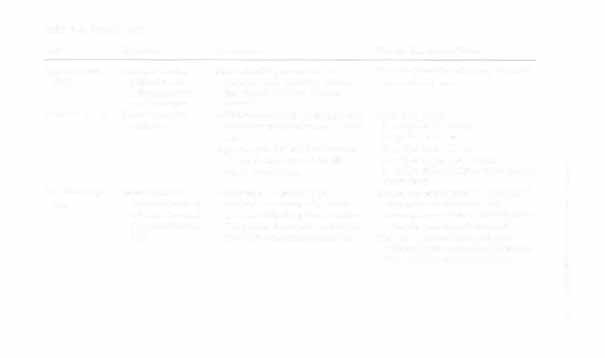Read i bc27f85be50b71b1 Online
Authors: Unknown
i bc27f85be50b71b1 (114 page)
extremity.
Auscultation
Systemic blood pressure and the presence of bruits (whooshing sound
indicative of turbulent blood flow from obstructions) are assessed
through auscultation.' Bruits are typically assessed by physicians and
nurses (see Chapter 1 for further details on blood pressure measurement).
Vascular Tests
Various tests that can be performed clinically to evaluate vascular flow
and integrity are described in Table 6-4. These tests can be performed
easily at the patient's bedside without the use of diagnostic equipment.
Diagnostic Studies
Noninvasive Laboratory SlIIdies
Various noninvasive procedures can examine vascular now. The
phrases lower-extremity noninvasive studies and carotid noninvasive
studies are general descriptions that are inclusive of the noninvasive
tests described in Table 6-5.
Invasive Vascular Studies
The most common invasive vascular study is arteriography, typically
referred to as contrasr angiography. This study provides anatOmic and
diagnostic information about the arterial system by injecting radiopaque dye into the femoral, lumbar, brachial, or axillary arteries, followed by radiographic viewing. An angiogram is a picture produced by angiography. Angiography is generally performed before or during
therapeutic interventions, such as percutaneous angioplasry, thrombolytic therapy, or surgical bypass grafting.
Postangiogram care includes the followingS:
•
Bed rest for 4-8 hours.
•
Pressure dressings to the injection site with assessment for
hematoma formation.
•
Intravenous nuid administration to help with dye excretion.
Blood urea nitrogen (BUN) and creatinine are monitored to ensure
proper renal function (refer to Chapter 9 for more information on
BUN and creatinine).


Table 6-4. Vascular Tests
Test
Indication
Description
Normal Results and Values
Capillary refill
To assess vacular
Nail beds of fingers or toes are
Blanching should resolve (capillary refill)
time
perfusion and
squeezed until blanching (whitenin less than 3 sees.
indirectly assess
ing) occurs, and then they are
cardiac ourpO[
released.
Elevation pallor
To assess anerial
A limb is elevated 30-40 degrees, and
Grading of palloro
perfusion
color changes are observed over 60
o = no pallor in 60 sees
sees.
1 = pallor in 60 sees
A gray or pale (pallor) discoloration
2 = pallor in 30-60 sees
will result from arterial insuffi3 = pallor in less than 30 sees
ciency or occlusion.
4 = pallor with limb flat (not elevated or
dependent)
�
Trendelenburg's
To determine if
A tourniquet is applied
<;:
ro the
Greater saphenous veins are involved if
'"
test
superficial or deep
involved lower extremity, which is
the varicosities fill slowly with the
�
""
veins are involved
elevated while the patient is supine.
tourniquet on and then suddenly dilate
in causing varicos
The patient then stands, and the fillwhen the tourniquet is removed.
�
ities
ing of the varicosities is observed.
Deep and communicating veins are
>
�
involved if the varicosities fill immediately with the tourniquet still on.
�
@
g
""
w
"
�

Table 6-4. Continued
'"
"
N
Test
Indication
Description
Normal Results and Values
Allen's test
To assess the patency
The radial and ulnar arteries are com
The pale and mottled hand that
�
of the radial and
pressed at the level of the wrist
results from arterial compression
ulnar arteries
while the patient clenches his or her
and clenching should resolve in the
§
fist. The patient then opens his or
arterial distribution of either the
�
her hand and either the radial or
radial or ulnar artery, depending on
"
the ulnar artery is released. The
which was released.
�
g
process is repeated for the other
'"
artery.
o
'"
Homans' sign II-
To detect the pres
The calf muscle is gently squeezed, or
Pain that is elicited with either squeezing
�
ence of deep vein
the foot is quickly dorsiflexed.
or dorsiflexing may indicate a deep
:t
-<
�
thrombosis
vein thrombosis.
�
,...
• A 50% false·posirive rare occurs with this test. Vascular laboratOry studies are more sensitive.
J!
Sources: Data from JM Black, E Matassarin-Jacobs (eds). Luckmann and Sorensen's Medical-Surgical Nursing: A Psycnophysiologic Approach
�
(4th ed). Philadelphia: Saunders, 1993; P Lanzer, J Rosch (eds). Vascular Diagnostics: Noninvasive and Invasive Techniques, Peri·lnterven
'"
tional Evaluations. Berlin: Springer-Verlag, 1994; and JW Hallet, DC Brewster, RC Darling (cds). Handbook of Patient Care in Vascular Sur
�
gery (3rd ed). Boston: Little, Brown, 1995.


Table 6-5. Noninvasive Vascular Srudies
Tesr
Description
Doppler ultrasound
High-frequency and low-intensiry (1-] 0 MHz) sound waves are applied to the
skin with a Doppler probe (and acoustic gel) CO detect the presence or
absence of blood flow, direction of flow, and flow character over 3neries and
veins with an audible signal. Low-frequency waves generally indicate lowvelocity blood flow,
Color duplex
Velociry patterns of blood flow along witb visual images of vessel and plaque anatscanning or imaging
omy can be obtained by combing ultrasound with a pulsed Doppler derector. Distinctive color changes indicate blood flow through a stenotic area.
Plethysmography
Plethysmography is the measurement of volume change in an organ or body region
'"
(5 types)
(volume change in this context refers CO blood volume changes that represent
Pulse volume recorder (PVR)
blood flow),
Ocular pneumoplerhysmography
PVR and OPG are used
�
CO evaluate arterial flow, whereas WG, PRG, and PPG are used
(OPG)
to evaluate venous flow.
�
-<
Impedance plethysmography (IPG)
Phlebotheography (PRG)
�
Phoroplerhysmography (PPG)
:>
6
; g -<
'"
"
'"


